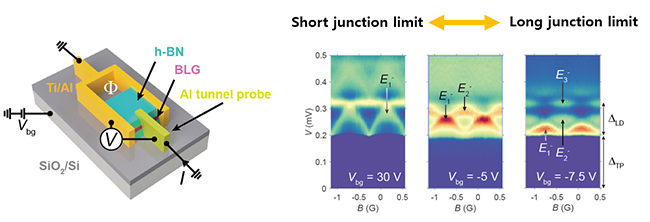A group of researchers from the Pohang University of Science and Technology and the National Institute for Materials Science have successfully controlled the quantum mechanical properties of Andreev-bound states in bilayer graphene-based Josephson junctions using gate voltage. The research was published in the journal Physical Review Letters.

Professors Gil-Ho Lee and Gil Young Cho from the Department of Physics at Pohang University of Science and Technology (POSTECH) in South Korea, in collaboration with Dr. Kenji Watanabe and Dr. Takashi Taniguchi from the National Institute for Materials Science (NIMS) in Japan, carried out the research.
Superconductors are substances that show zero electrical resistance in some circumstances, such as at very low temperatures or high pressures. The proximity effect, in which superconductivity extends into the normal conductor, causes a supercurrent to flow through a very thin normal conductor between two superconductors.
This apparatus is referred to as a Josephson junction. Andreev-bound states are novel quantum states that arise within the normal conductor and play a critical role in mediating the supercurrent flow.
The ratio of the “conduction channel length” (the length of the normal conductor) to the “superconducting coherence length” (the length along which the superconducting state can be maintained in the normal conductor) determines the number of energy levels in the Andreev bound states, which determines the electrical properties of a Josephson junction.
The system is said to be in the “short junction limit” when the conduction channel is short, and there are only two Andreev-bound state levels. On the other hand, the term “long junction limit” is used when there are more than two pairs.
In this work, the researchers employed gate voltage to regulate time, both the superconducting coherence length and the quadratic energy dispersion of bilayer graphene. They observed the changing of the Andreev bound states at various gate voltages in real time using tunneling spectroscopy, which they created in their prior work, and they verified that the experimental results matched theoretical expectations.
We have observed the Andreev bound states in the long Josephson junction limit, a phenomenon predominantly seen in the short Josephson junction limit. We anticipate that the number of energy levels can be readily adjusted by applying gate voltage alone, offering potential applications in diverse fields such as quantum computing and high-precision quantum sensors.
Geon-Hyoung Park, Study Lead Author and Researcher, Quantum Information Device Research and Education Center, Pohang University of Science and Technology
The research was funded by the National Research Foundation of Korea, the Ministry of Science and ICT, the ITRC, the Air Force Office of Scientific Research, the Institute for Basic Science (IBS), the Samsung Future Technology Incubation Program, Samsung Electronics, the Basic Science Research Institute, the JSPS KAKENHI, and the World Premier International Research Center Initiative (WPI).
Journal Reference:
Park, G.-H., et al. (2024) Andreev Bound States in Bilayer Graphene Josephson Junctions from Short to Long Junction Limits. Physical Review Letters. doi.org/10.1103/physrevlett.132.226301.

